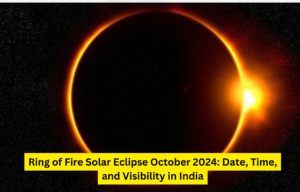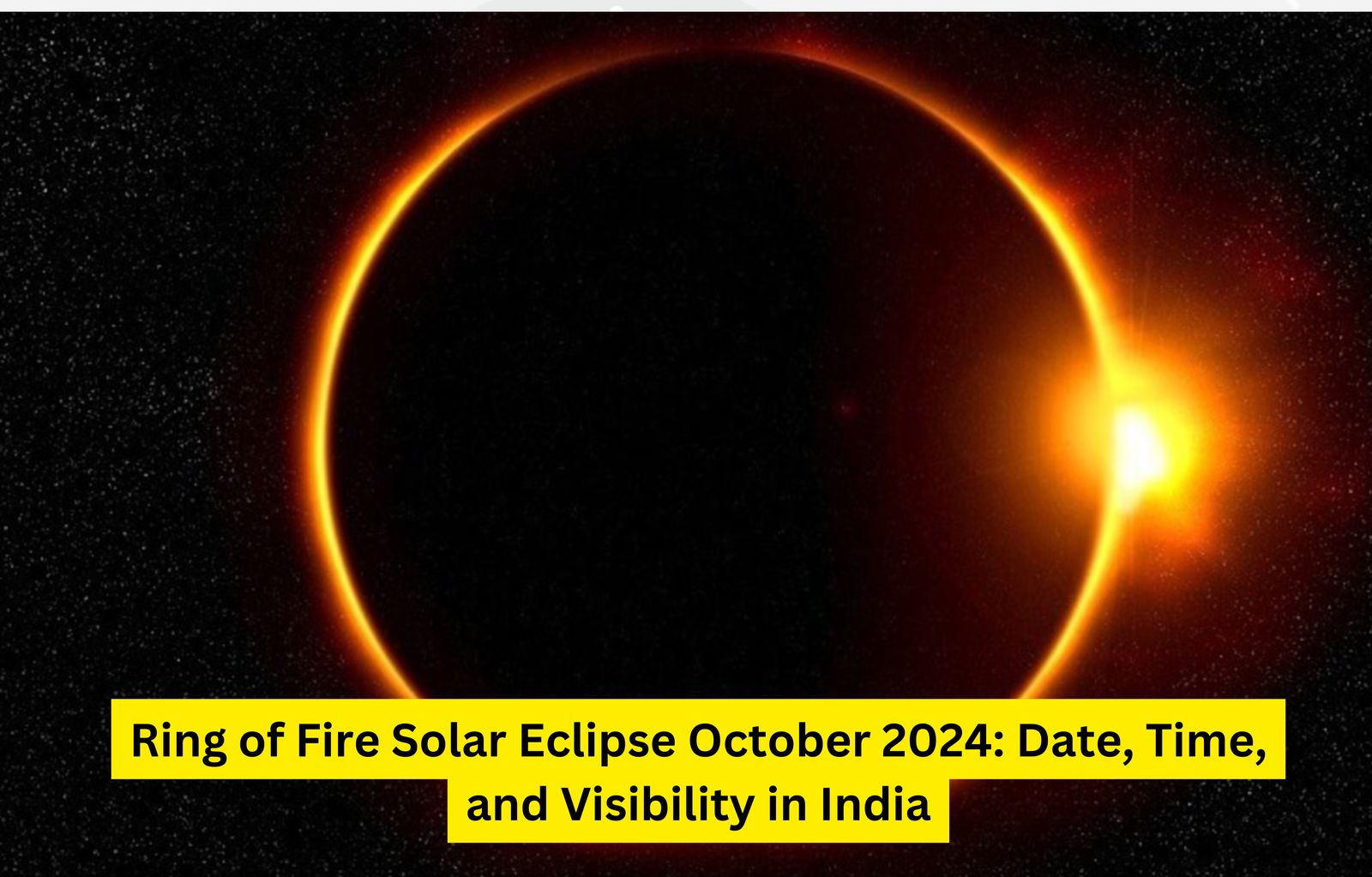Ring of Fire Solar Eclipse October 2024: Date, Time, and Visibility in India – All You Need to Know

One of the most anticipated astronomical events of 2024 is the Ring of Fire Solar Eclipse, also known as the Annular Solar Eclipse. This breathtaking event occurs when the Moon passes between the Earth and the Sun, covering the Sun’s center and leaving a bright, fiery ring around its edges. The October 2024 Solar Eclipse promises to be an unforgettable experience for sky watchers across the world, but will it be visible from India? In this article, we will provide all the important details regarding the date, time, visibility in India, and tips on how to safely observe this celestial spectacle.
also read: Jio Revolutionizes Telecom: Unlimited Calling, Free Data, and More in New Plan at Unbeatable Price
What is a Ring of Fire Solar Eclipse?
The Ring of Fire Solar Eclipse, or Annular Solar Eclipse, occurs when the Moon is slightly farther away from the Earth in its orbit. As a result, the Moon appears smaller in the sky and does not completely cover the Sun, leaving a bright ring of sunlight around the edges. This ring, often referred to as the “ring of fire”, creates a spectacular and rare visual phenomenon.
Unlike a total solar eclipse, where the Sun is fully obscured, the Annular Eclipse allows a thin, glowing ring of the Sun to remain visible. This unique alignment of celestial bodies is both mesmerizing and scientifically significant, offering astronomers and enthusiasts a rare opportunity to observe the interactions between the Sun, Moon, and Earth.
also read: China’s Smart Dragon-3 Sea Launch Marks a New Milestone in Space Technology
Date and Time of the Ring of Fire Solar Eclipse in October 2024
Mark your calendars, as the Ring of Fire Solar Eclipse is set to occur on October 2, 2024. The exact timing of the eclipse will vary depending on your location, but the primary phases of the event are as follows:
- Partial Eclipse begins: 13:05 (UTC)
- Annular Phase begins: 14:16 (UTC)
- Maximum Eclipse: 15:00 (UTC)
- Annular Phase ends: 15:45 (UTC)
- Partial Eclipse ends: 16:55 (UTC)
These times are listed in Coordinated Universal Time (UTC), so viewers in India will need to adjust according to Indian Standard Time (IST). The Annular Phase will be visible only in certain regions where the alignment is perfect, while others will experience a partial eclipse.
Visibility in India: Can We See the Eclipse?
Unfortunately for Indian skywatchers, the October 2024 Ring of Fire Solar Eclipse will not be fully visible across most parts of India. The annular phase of the eclipse will primarily be visible in regions such as North America, parts of Central America, and South America. However, depending on your location, some areas in western and southern India may catch a glimpse of a partial solar eclipse during the event.
Although India will not experience the full annular eclipse, a partial solar eclipse is still an extraordinary sight. The partial eclipse will be visible for a short period in some parts of western India, where the Moon will cover only a portion of the Sun’s disk, creating a crescent-shaped Sun.
Best Locations for Viewing the Eclipse Globally
While India may not be in the prime viewing zone for the Ring of Fire, there are several regions around the world where the Annular Eclipse will be visible in its full glory. If you’re an eclipse chaser and looking to travel to witness the event, the best locations include:
- United States (Western regions): Major cities like Oregon, Nevada, and Texas will be in the direct path of the Ring of Fire.
- Mexico: Certain regions in Mexico will witness the full annular eclipse.
- Central America: Countries like Belize, Honduras, and Panama will be treated to stunning views.
- South America: Portions of Brazil will experience the eclipse.
For those unable to travel, many observatories and space agencies will offer live-streams of the event, ensuring that people around the world can witness this astronomical marvel from the comfort of their homes.
How to Safely Watch the Solar Eclipse
Watching a solar eclipse can be a mesmerizing experience, but it is crucial to take the proper safety precautions to protect your eyes. Looking directly at the Sun during an eclipse, even during the annular phase, can cause serious damage to your eyesight. Here are some tips for safely observing the eclipse:
- Use Proper Solar Viewing Glasses: Regular sunglasses are not safe for viewing a solar eclipse. Make sure to use certified solar eclipse glasses that meet the ISO 12312-2 safety standards.
- Pinhole Projector: You can create a simple pinhole projector to safely view the eclipse without looking directly at the Sun. This involves making a small hole in a piece of paper and projecting the sunlight onto a flat surface.
- Solar Filters for Telescopes: If you plan on using a telescope or binoculars to observe the eclipse, make sure they are equipped with special solar filters to protect your eyes.
- Never Look Through Unfiltered Devices: Avoid looking at the eclipse through a camera, binoculars, or telescope without a proper solar filter, as this can intensify the sunlight and cause severe eye damage.
By following these precautions, you can enjoy the Ring of Fire without compromising your safety.
The Science Behind the Annular Solar Eclipse
The Annular Solar Eclipse provides a fascinating glimpse into the mechanics of our solar system. During this event, the Moon is positioned farther away from the Earth, which means it appears smaller in the sky and does not completely cover the Sun. This allows a thin ring of sunlight to shine around the Moon, creating the striking “ring of fire” effect.
For astronomers, solar eclipses offer a valuable opportunity to study the Sun’s outer atmosphere, known as the corona. During the eclipse, the brightness of the Sun is reduced, allowing scientists to observe the corona’s structure and behavior. This helps them gain insights into solar flares, solar winds, and other phenomena that can impact the Earth’s atmosphere and technological systems, such as satellites and power grids.
Myth and Legend: Solar Eclipses in Indian Culture
Solar eclipses have long held a place of significance in Indian culture and mythology. In ancient Hindu texts, solar eclipses were often explained as the celestial demon Rahu swallowing the Sun. According to legend, Rahu was beheaded by Lord Vishnu, and his head and body were cast into the sky. The head, known as Rahu, occasionally devours the Sun, causing an eclipse.
Although these myths are not believed today, solar eclipses still inspire awe and reverence in many parts of India. People often observe religious practices during eclipses, such as fasting and offering prayers.
Frequently Asked Questions (FAQ)
1. What is a Ring of Fire Solar Eclipse?
A Ring of Fire Solar Eclipse, or Annular Solar Eclipse, happens when the Moon is slightly farther from Earth in its orbit, making it appear smaller in the sky. As a result, the Moon does not completely block the Sun, leaving a visible, fiery ring of sunlight. Unlike a total solar eclipse, where the Sun is entirely covered, the Ring of Fire allows part of the Sun’s outer edges to remain visible.
2. When will the October 2024 Solar Eclipse occur?
The October 2024 Ring of Fire Solar Eclipse will take place on October 2, 2024. The eclipse will begin in the early afternoon and will last for several hours. Here are the key timings in Coordinated Universal Time (UTC):
- Partial Eclipse begins: 13:05 (UTC)
- Annular Phase begins: 14:16 (UTC)
- Maximum Eclipse: 15:00 (UTC)
- Annular Phase ends: 15:45 (UTC)
- Partial Eclipse ends: 16:55 (UTC)
Please note that these times are in UTC, and viewers in India will need to adjust for Indian Standard Time (IST), which is UTC +5:30.
3. Will the Ring of Fire Solar Eclipse be visible in India?
Unfortunately, the annular phase of the October 2024 Solar Eclipse will not be visible from India. The regions that will witness the full Ring of Fire include parts of North America, Central America, and South America. However, certain parts of western and southern India may experience a partial solar eclipse. This means that only a portion of the Sun will be covered by the Moon, creating a crescent-like effect.
4. How much of the eclipse will be visible in India?
While the annular phase of the eclipse won’t be visible in India, the partial eclipse will be visible in select regions. Areas in western and southern India are likely to experience the best views, although the eclipse will not be as dramatic as in other parts of the world. In these regions, the Moon will cover part of the Sun, but the characteristic ring of fire will not be visible.
5. Where can I watch the Ring of Fire Solar Eclipse live?
If you’re in a location where the Ring of Fire is not visible, you can still watch the eclipse via live streams provided by various space agencies, astronomical societies, and online platforms. Several organizations will broadcast the eclipse in real-time, allowing viewers across the globe to witness the event safely and comfortably.
6. What safety precautions should I take when watching the eclipse?
Observing a solar eclipse is an incredible experience, but it is crucial to follow safety guidelines to avoid damaging your eyesight. Here are some important precautions:
- Wear certified solar eclipse glasses: Regular sunglasses will not protect your eyes from the Sun’s harmful rays. Use ISO-certified eclipse glasses to safely view the event.
- Avoid looking directly at the Sun: Even during a partial eclipse, looking directly at the Sun can cause permanent eye damage. Always use proper viewing equipment.
- Use solar filters for telescopes: If you plan to view the eclipse through a telescope or binoculars, ensure that the lenses are equipped with solar filters to protect your eyes.
7. What is the scientific significance of the Annular Solar Eclipse?
Annular solar eclipses, like the Ring of Fire, provide a unique opportunity for scientists to study the Sun’s atmosphere. During the eclipse, the corona, or outer layer of the Sun, becomes more visible. Scientists can observe solar activity, such as solar flares and coronal mass ejections, which can influence Earth’s magnetic field and communication systems.
8. What myths and legends surround solar eclipses in India?
In Indian culture, solar eclipses have been surrounded by myths and legends for centuries. One popular legend is that of Rahu, a demon who is said to swallow the Sun, causing an eclipse. This myth originates from ancient Hindu texts, and even today, some people in India follow traditional practices, such as fasting or staying indoors, during an eclipse.
9. How does a solar eclipse impact daily life?
While modern science has dispelled many superstitions about solar eclipses, some people still believe in traditional practices during these events. In parts of India, people may avoid eating or drinking during the eclipse, and some religious communities perform special prayers. However, from a scientific standpoint, there is no need to change daily routines during an eclipse, as it does not have any direct impact on health or well-being.
10. Can I photograph the eclipse?
Yes, you can photograph the solar eclipse, but you must take precautions to avoid damaging your camera equipment. Use solar filters for your camera lens to protect it from the Sun’s intense light. It’s also a good idea to use a tripod and remote shutter release for stable and safe photography during the eclipse.
The October 2024 Ring of Fire Solar Eclipse is an astronomical event that promises to captivate skywatchers worldwide. While India may not experience the full annular eclipse, a partial eclipse will still be visible in some regions, allowing Indians to witness a piece of this cosmic wonder.
Whether you’re planning to view the eclipse in person or watch it via live streams, make sure to follow the necessary safety precautions and enjoy the spectacle. Keep your eyes on the sky and prepare for an unforgettable celestial experience!





